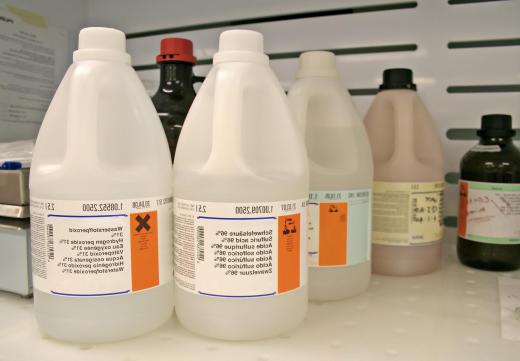What Is the Connection between Ethanol and Sulfuric Acid?
The connection between ethanol and sulfuric acid involves at least three possible reaction pathways. They are esterification — involving either one or two molecules of ethanol, or alcohol — and dehydration, again involving either one or two alcohol molecules. If dehydration involves only one molecule each of ethanol and sulfuric acid, the product is a gas, important in nature and useful in the laboratory and in industry. When two molecules of alcohol are united by dehydration, a liquid of historical medical significance is the result. Both esterification products are of limited use.
Sulfuric acid is not only a very strong acid, but it is an exceptional dehydrating agent as well. It is so strong an acid, it can ionize itself, even without water, whereas as a dehydrator, it can "rip" hydrogen and oxygen atoms out of molecules to satisfy its "thirst." This latter characteristic is demonstrated through the simple high school experiment in which a few grains of table sugar, C12H22O11, are combined with a some drops of concentrated sulfuric acid in a test tube or beaker. In seconds, the reactants become pitch black and boil violently. The black color is due to the now elemental 12 carbon atoms from each sugar molecule, whereas the 22 hydrogen and 11 oxygen atoms that were stripped off have been turned into 11 molecules of water.

Ethanol, also called ethyl alcohol or grain alcohol, is very similar to water. Its structure is CH3CH2OH. Basically, ethanol is simply water, with one of its hydrogen atoms replaced by a carbon-based handle, the relatively inert CH3CH2-. Another way to look at ethanol is as a very weak base, resembling — at least superficially — sodium hydroxide, NaOH. Although ethanol is ordinarily too weak a base to ionize, under certain conditions it should be capable of producing salt-like structures.

Sodium hydroxide can produce either of two salts with sulfuric acid, one of which is sodium hydrogen sulfate (NaHSO4), derived from one molecule of base and one of acid. Although it is a salt, it is also an acid, since it still retains one hydrogen atom in its structure. If this acid-salt is reacted with a second molecule of NaOH, a neutral salt results — sodium sulfate (Na2SO4). Correspondingly, if ethanol and sulfuric acid are combined under mild and controlled conditions, ethyl hydrogen sulfate results via the reaction pathway CH3CH2OH+H2SO4→CH3CH2OSO3H, whereas if this acid-ester resulting from the combination of ethanol and sulfuric acid is further reacted with another molecule of ethanol, diethyl sulfate — called more simply, ethyl sulfate — results. Interestingly, although it is of limited use, forensic scientists employ ethyl sulfate to detect alcohol in the blood and urine, days after it has been consumed.
Under more rigorous conditions, esterification is replaced by dehydration. Single molecule dehydration follows the equation CH3CH2OH→CH2=CH2+HOH. The gaseous product is ethylene, a plant hormone associated with the ripening of fruits and other processes. If two molecules of ethanol are dehydrated rather than one, the reaction is 2 CH3CH2OH→CH3CH2OCH2CH3+HOH. This reaction results in a historically significant end-product: the anesthetic liquid, ethyl ether.
The connection between ethanol and sulfuric acid is thus at least four-fold. The results of their combination include two esterification products and two dehydration products, depending upon the conditions under which the reaction is carried out. Besides gentle reaction conditions, the product of esterification depends upon how much of each reactants there is at any time during the reaction. Dehydration also depends upon the relative population of ethanol and sulfuric acid at all times during reaction.
AS FEATURED ON:
AS FEATURED ON:












Discuss this Article
Post your comments